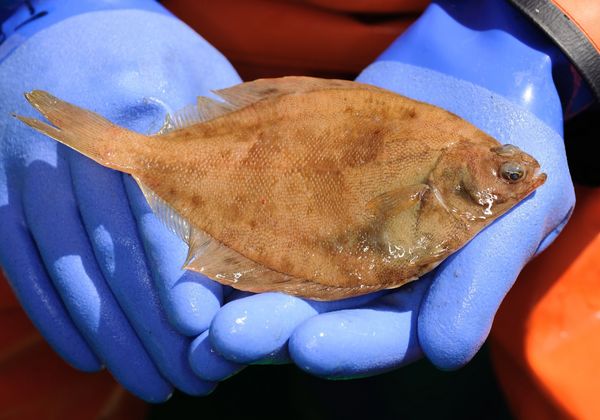Expertise
Mercury in fish from German marine areas
Ulrike Kammann, Marc-Oliver Aust, Pedro Nogueira, Klaus Wysujack | 20.01.2023
Mercury is one of the most toxic elements on our planet and is distributed worldwide. The levels of mercury in fish from German marine areas are regularly monitored by the Thünen Institute. The results are incorporated into national and European environmental assessments.

How much mercury (Hg) is present in marine fish from the North Sea and Baltic Sea? Mercury is a special metal: not only is it particularly toxic, but unlike many other pollutants, it is mainly distributed through the air and reaches the sea with the rain (atmospheric deposition). Once in the sea, Hg can be converted by microorganisms into methyl Hg – a substance that behaves in the environment not like a metal but like an organic pollutant and accumulates in the fatty tissue of marine fish. The predominant amount of Hg in marine fish is therefore present as methyl Hg and shows a strong tendency to bioaccumulate. This means that older animals of the same species and origin are regularly more highly contaminated with mercury than younger ones.
At the Thünen Institute of Fisheries Ecology, we study fish from the Exclusive Economic Zone (EEZ) of Germany (up to 200 nautical miles from the coast) always from the same marine regions, the location of which is based on the natural distribution of the respective fish species. The Thünen Institute performs this task within the framework of its sovereign obligations for the European Marine Strategy Framework Directive in cooperation with the International Council for the Exploration of the Sea (ICES), the Oslo-Paris Convention for the Protection of the Marine Environment of the North-East Atlantic (OSPAR) and the Helsinki Convention for the Protection of the Marine Environment of the Baltic Sea (HELCOM).
Material and Methods
The fish species dab (Limanda limanda, Fig. 1) is caught on our regular research cruises with the Walther Herwig III (Link) in the EEZ of the North and Baltic Seas during the months of August and September. A small portion of the muscle tissue is freeze-dried in the laboratory and ground to a fine powder. A few milligrams of the dry fish muscle powder are used for measurement in a "Direct Mercury Analyzer".
Baseline data
Baseline data are the typical contamination of a fish species of a sea area in a period of time e.g. with mercury. They serve as a basis for the assessment of the state of the marine environment, e.g. according to EU MSFD. The sea area under consideration is the EEZ in the North Sea and Baltic Sea. The selected period from 2010 to 2020 is long enough to calculate representative mean values with high sample numbers. Table 1 summarizes the baseline data on Hg contamination of different fish species: We find the highest values on average in dab from the EEZ in the North Sea. Dab, cod and herring from the Baltic Sea are all lower contaminated.
Evaluation of the basis data
Are the measured levels of mercury in marine fish of concern? The MSFD considers Hg contamination in marine fish from two aspects: On the one hand, fish are an indicator of the state of the ecosystem and should not suffer from effects of environmental pollution; on the other hand, fish should be safe to eat as food.
The assessment of our baseline data regarding environmental pollution is performed using the environmental quality standard of 20 μg/kg wet weight for biota. The mean loads in dab and cod (Table 1) exceed this limit. Herring in the Baltic Sea is on average exactly at the level of the limit value. According to the MSFD, the good environmental status for dab and cod in the EEZ of the North Sea and Baltic Sea has not yet been achieved.
Considering marine fish as food, their Hg load can be considered harmless, as it is well below the EU limit of 500 μg Hg/kg wet weight for fish as food. None of the fish caught between 2010 and 2020 exceeded this limit. These fish from the German EEZ can therefore be consumed without concern.
Regional differences in baseline data
Are there also regional differences in the Hg load of marine fish within the EEZ? Broken down by stations in the North Sea EEZ, the highest values tend to be found in the inner German Bight at the nearshore station GB1 (Fig. 2). The mean values decrease in the North Sea EEZ from the coast towards the open North Sea - at least in tendency. In the North Sea, the stations hardly differ from each other in their load (Fig. 2). However, there is a significant difference between the Baltic Sea area B01 and each North Sea station. The Hg load in the North Sea and the Baltic Sea represents a legacy load – that is, it reflects the sum of the inputs from the last decades rather than new inputs.
Trend: the load is increasing
If the Hg concentration in dab from the inner German Bight (N01, Fig. 2) is considered, an increasing temporal trend in the Hg load over the last 25 years can be seen (Fig. 3). This significant trend cannot be explained by effects such as bioaccumulation and is not reflected in sediment Hg concentrations.
This surprising observation may be a possible effect of climate change, such as a shift in the food supply for fish in this region or an increased release of Hg from the sediment in parallel with the increase in water temperature. This temporal trend in Fig. 3 results in a clear increase in Hg levels in fish of 1.4% per year over the last 25 years. This results in a total increase of 41% in Hg loading over this time period. This phenomenon only affects the shallower and therefore warmer coastal area of the North Sea at the seafloor.
More Information:
- Thünen à la Carte 11Environmental contamination: Mercury in fish(6 p., in German)


![Overview of regional differences in mercury load [μg Hg/kg wet weight] of three fish species dab (purple), cod (green) and herring (blue). Karte von Nordsee und Ostsee mit der Höhe der Quecksilberbelastung der Fischarten Kliesche, Dorsch und Hering als Balkendiagramm.und](/media/_processed_/3/4/csm_Expertise_Quecksilber_Abb2_Karte_717a891741.jpg)
![Temporal trend of mercury load [μg Hg/kg wet weight] in dab at station N01 in the North Sea over 25 years. Diagramm zur steigenden Belastung von Klieschen in der Nordsee mit Quecksilber über 25 Jahre.](/media/_processed_/7/f/csm_Expertise_Quecksilber_Abb3_Grafik_db98237330.jpg)
![[Translate to English:] Logo des Bundesministerium für Ernährung und Landwirtschaft](/media/allgemein/logos/BMEL_Logo.svg)